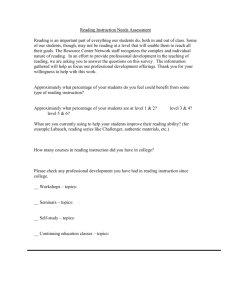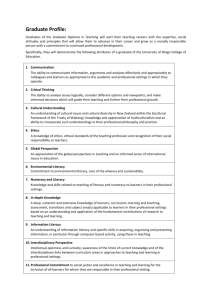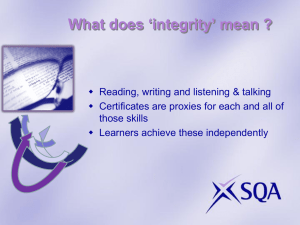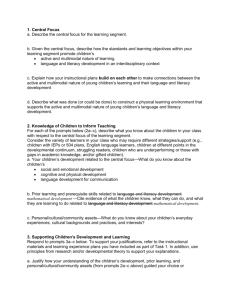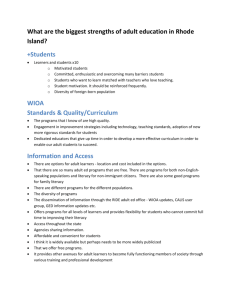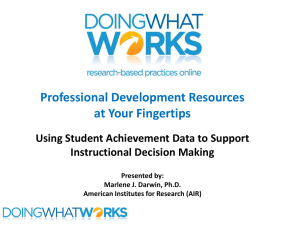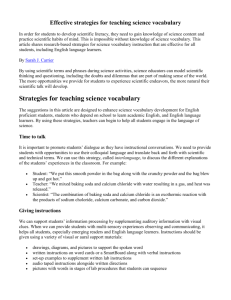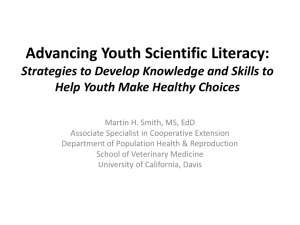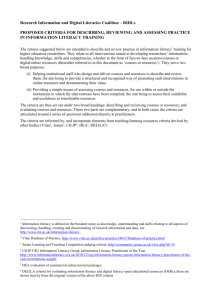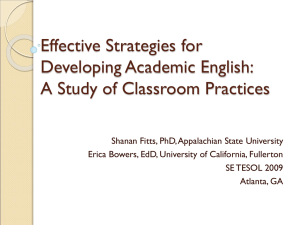Instructional Technology Presentation
advertisement
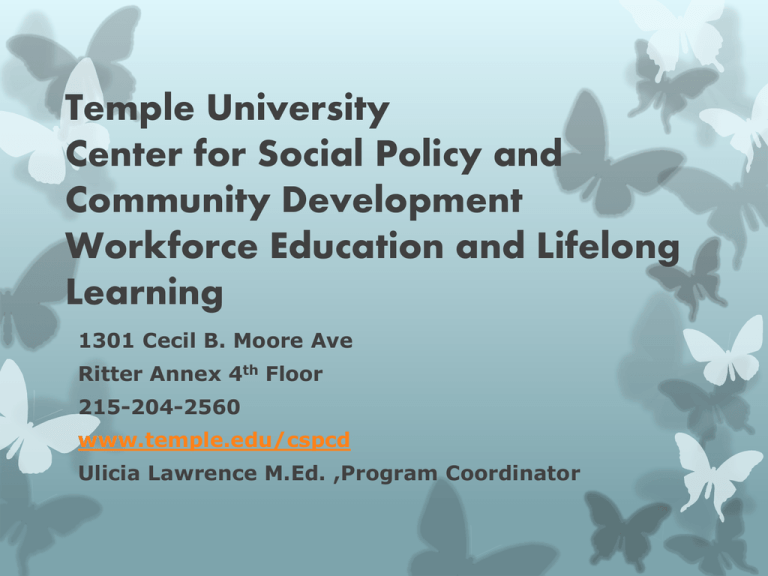
Temple University Center for Social Policy and Community Development Workforce Education and Lifelong Learning 1301 Cecil B. Moore Ave Ritter Annex 4th Floor 215-204-2560 www.temple.edu/cspcd Ulicia Lawrence M.Ed. ,Program Coordinator Adult Literacy and Education Literacy is the ability to read, write, compute and use technology, to achieve one's goals, function in society, and to develop one's knowledge and potential. VISION FOR WELL TECHNOLOGY All Adult learners will be able to use technology to achieve their personal goals, advance academic proficiency and function in society. Technology Planning Team Program Improvement External Members Northwest CareerLink CHPSW Tech Division Pan African Studies Community Education Program Mayor’s Commission on Literacy Learn Philly Coalition Program Improvement Internal Team CSPCD Workforce Division WELL Instructional Staff TU Tutor Corp members WELL student ambassadors Technology Meetings Program Improvement team meetings are scheduled the first Friday monthly. Members of the technology team include internal and external members who have a vested interest in the integration and infusion of technology. Instructional Delivery Assessment Engagement Academic advancement Learner Persistence Curriculum Integration 2005 PA Dept. of Education Bureau of Adult Basic Literacy and Education mandated the inclusion of computer literacy into adult education programs. 2006 Pilot distance Learning programs funded 2007 GED Connection , www pbs.org/literacy, License purchased by PDE for use by state funded programs 2008 -2009 Technology oriented curriculum further integrated into adult literacy programs through Skills Tutor and TV 411. 2009 – 2010 CCSPCD programs integrate on line assessment into program and becomes a referral source for Distance Learning programming facilitated by the state. 2010-2011 WELL develops its own Wiki site and Facebook site to connect and engage learners 2011-2013 Blended classes utilizing distance learning, technology (cell phones) and career curriculum Staff Professional Development Webinars Webex Linda.com TU computer Training PDE Adult Education Overview World Education Adult literacy Education Technology for adult learning must be multifaceted and relevant. The Workforce Education and Lifelong Learning program has taken incremental steps to include technology into the program design for the past 8 years. First using audio video equipment for learner engagement, then requiring the use of DVD lessons for homework completion and finally including Blended learning through Distance Learning. A small computer lab of five computers provided introduction to job search and career exploration via the internet. Common Core standards have now increased the need to further enhance the use of technology to promote career and college acquisition. Ethernet Drops limited access to the TU network. Wireless access interrupted due to TU Recycling Center building constraints. provides a bay of 10 Signals blocked. 4 computers year quest for perfection Present Hardware Computers Name Processor Number Computers in: DELL laptops Intel 3 Mobile laptops w/Projector Dell Desktops Intel 15/10 Labs: 575 Ritter Classroom: Mitten 202 Dell Desktops Intel 7 Staff Offices Number 3 1 1 1 1 Peripheral Devices Overall Count Inkjet Printers Color Laser Printers Laser Printers Fax/Scanners Digital Still Cameras Digital Movie Cameras LCD Projectors Interactive WhiteBoards (SMART) Interactive WhiteBoards (Promethean) Interactive WhiteBoards (Other, please specify brand) Student Response Systems iPads Tablets Other Devices (Please Identify) Action Plan Develop a learning community with technology Engage all adult learners from student to administration in continuous knowledge enhancement Prepare adult literacy learners to be competitive in a global market through technology Instructional goals for your school All classes will use technology possessed by the student and the program to engage learners o Students will use their personal cell phones during class as a learning tool o Teachers will interact with students via technology for continuous learning Apply existing knowledge to generate new ideas, products, or processes Promote student reflection using collaborative tools to reveal and clarify students conceptual understanding, thinking, planning, and creative process Instructional goals for your school From Adult Basic to Transition to college students will learn to independently access information for career development and employment o Adult basic students will become knowledgeable about the proper use of the cell phones and computers o Advance learners’ will interact with instructors through technology for homework help, career development and employment acquisition Communicate information and ideas effectively to multiple audiences using a variety of media and formats Identify and define authentic problems and significant questions for investigation Instructional goals for your school Teachers will enhance learners and learners will enhance teachers as technology advances o Teachable moments will be recognized and used for reciprocity of learning o Teachers will be confident enough to turn over instruction to students who are proficient in new technologies as they grow Students will exhibit a positive attitude toward using technology that supports collaboration, learning and productivity Provide students with multiple and varied formative and summative assessments aligned with content and technology standards and use resulting data to inform learning and teaching Instructional goals for your school Classes are developed to be accessed via internet , face to face or through multimedia venues o The program is developed and designed to be accessed on line for global learning Demonstrate fluency in technology systems and the transfer of current knowledge to new technologies and situations Resources Required How many? Of what? Laptops/tablets Single item purchase price $199. Multiple item purchase price What budget will money come from? (i.e. Capital Budget, 20 $3980.00 Operating Budget, Grant, Title I, etc.)Demonstration Grant Cost Analysis and Justification (Budget Narrative) – Briefly describe the overall costs, including an analysis and justification Instead of purchasing top of the line products we will begin with refurbished products for learning Teachers will use technology for Professional development Students will combine personal items with integration of new technology learning Summary Statement The Workforce Education and Lifelong learning program will design a learning environment that challenges the current knowledge, skills, and interest of both student and teacher to seek creative, innovative, and technological advances as citizens, workers and family members. Through technology the program engages adult learners in the use of tools they possess for academic enhancement while introducing current innovation to address “real world” issues and problems The programs seeks to be known as the “Community of Learning for all adults”
